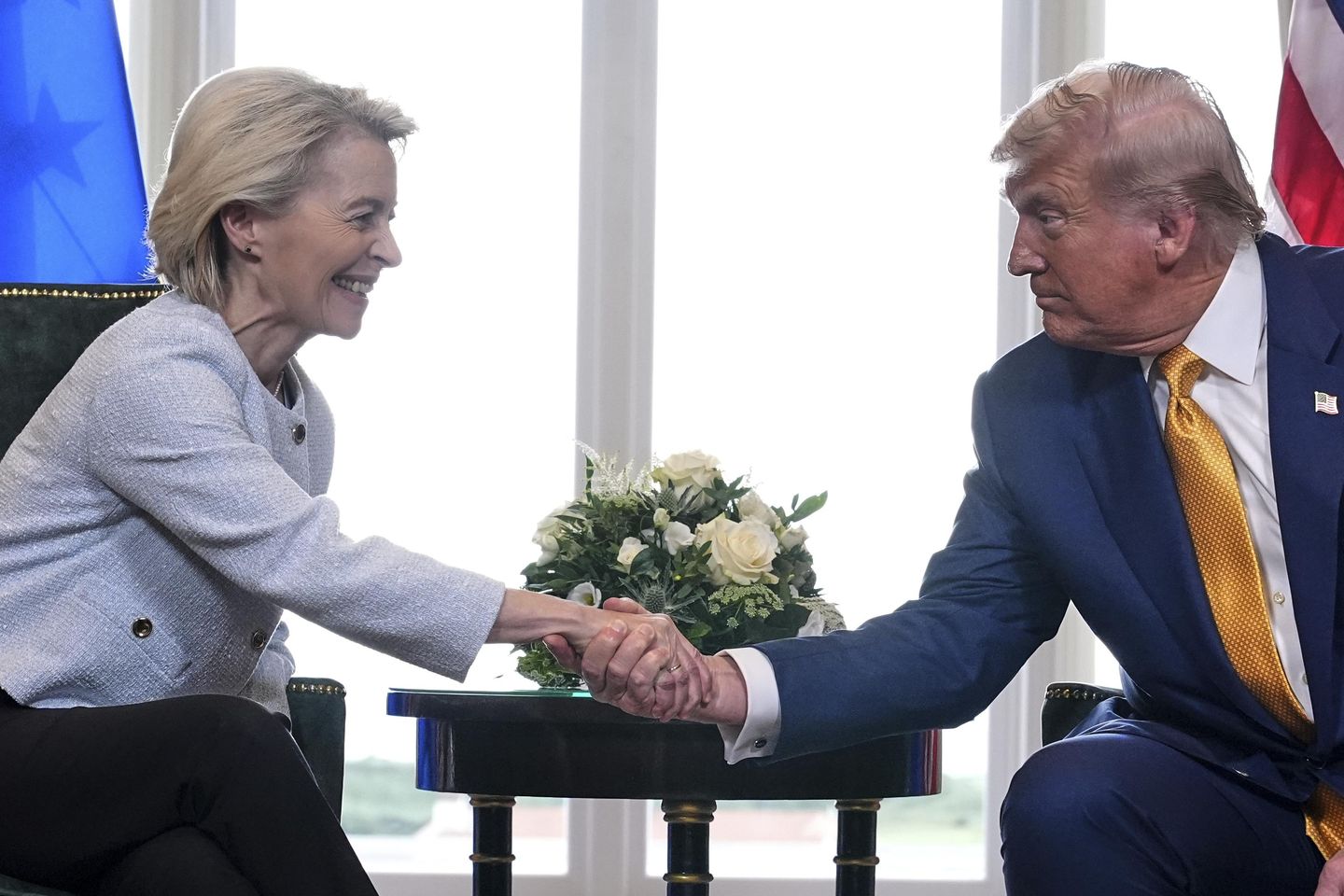
Don’t miss the full story from our staff writers, whose reportage is the basis of this article.
The United States and European Union have successfully negotiated a comprehensive trade agreement, averting a potential trade war that threatened to escalate on Friday. President Trump and European Commission President Ursula von der Leyen announced the deal at the president’s Turnberry golf course in Scotland following intense negotiations.
The agreement addresses the significant trade imbalance between the two economic powers, with the U.S. suffering a $235.6 billion trade deficit with the EU in 2024—a 12.9% increase from the previous year. Under the new framework, European markets will open to U.S. goods while the U.S. will impose a 15% tariff on EU products, replacing Mr. Trump’s threatened 30% tariff that would have triggered retaliatory measures.
The deal includes substantial European commitments beyond tariff adjustments. The EU will purchase $750 billion in American energy products, invest $600 billion in the United States, and buy significant quantities of U.S. military equipment. Trump hailed it as “the biggest deal ever made” and “a good deal for everybody.”
European tariffs on many US goods will be reduced from under 3% to zero, though full details remain undisclosed. The 15% U.S. tariff will apply to automobiles, but pharmaceuticals are excluded from the agreement. Steel and aluminum tariffs will remain at 50%, reflecting President Trump’s emphasis on domestic pharmaceutical production for national security reasons.
This EU agreement represents part of Mr. Trump’s broader trade realignment strategy, dubbed “Liberation Day” tariffs, targeting nations without new U.S. trade agreements by Friday. The administration has already secured deals with Britain, Indonesia, Japan, the Philippines, and Vietnam, generating $27 billion for the U.S. Treasury through various arrangements involving reduced tariffs in exchange for investments and market access.
Ongoing negotiations continue with other major trading partners. The U.S. and China agreed in May to lower some tariffs by 115% with a 90-day pause on Chinese goods tariffs expiring August 12. A U.S. delegation will travel to Stockholm next week for continued China talks. South Korea is also engaged in new trade agreement discussions, while negotiations with Mexico and Canada have proven less productive.
Ms. Von der Leyen emphasized the deal’s mutual benefits, stating it would create “good jobs on both sides of the Atlantic” and “prosperity on both sides of the Atlantic.” The agreement came after EU leaders estimated only “50-50” chances of reaching a Sunday deal, with Mr. Trump rejecting European proposals for a 10% tariff rate. President Trump plans to finalize additional U.K. trade details when meeting Prime Minister Keir Starmer on Monday.
Read more: Trump, EU strike historic trade deal in Scotland
This article is written with the assistance of generative artificial intelligence based solely on Washington Times original reporting and wire services. For more information, please read our AI policy or contact Ann Wog, Managing Editor for Digital, at awog@washingtontimes.com
The Washington Times AI Ethics Newsroom Committee can be reached at aispotlight@washingtontimes.com.



![Former Bravo Star Charged After Violent Assault Using a Rock-Filled Sock in Tennessee Walmart [WATCH]](https://www.right2024.com/wp-content/uploads/2025/07/Former-Bravo-Star-Charged-After-Violent-Assault-Using-a-Rock-Filled-350x250.jpg)



![NYC Man Snatches Child Off The Sidewalk, Parents Chase Him Down [WATCH]](https://www.right2024.com/wp-content/uploads/2025/07/NYC-Man-Snatches-Child-Off-The-Sidewalk-Parents-Chase-Him-350x250.jpg)
![Karoline Leavitt Levels CNN's Kaitlan Collins and Other Legacy Media Reporters [WATCH]](https://www.right2024.com/wp-content/uploads/2025/07/Karoline-Leavitt-Levels-CNNs-Kaitlan-Collins-and-Other-Legacy-Media-350x250.jpg)
![Man Arrested After Screaming at Senators During Big Beautiful Bill Debate [WATCH]](https://www.right2024.com/wp-content/uploads/2025/06/Man-Arrested-After-Screaming-at-Senators-During-Big-Beautiful-Bill-350x250.jpg)
![Leftists Lose Their Minds After Jason Kelce Celebrates Being an American [WATCH]](https://www.right2024.com/wp-content/uploads/2025/07/Leftists-Lose-Their-Minds-After-Jason-Kelce-Celebrates-Being-an-350x250.jpg)
![Illegal Alien Walked Free After Decapitating Woman, Abusing Corpse for Weeks [WATCH]](https://www.right2024.com/wp-content/uploads/2025/07/1753013138_Illegal-Alien-Walked-Free-After-Decapitating-Woman-Abusing-Corpse-for-350x250.jpg)





